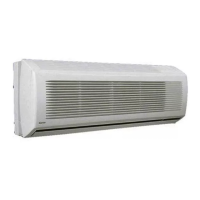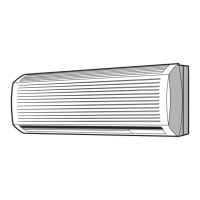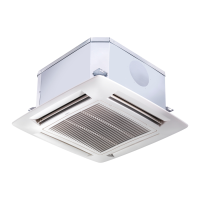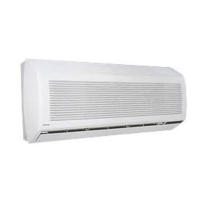42 WHC/WHE
GB - 12
Controls and functions
Two types of electromechanical controls are available:
a) control for unit without electric heater.
b) control for unit with electric heater.
Both the controls are electromechanical and do not therefore permit
the operation of groups of units and/or the connection of supervisor
and control systems.
• Position the control on a non-perimeter wall
• Position the control away from sources of heat
• Position the control so that it is not reached by the air flow leaving
the unit
• Position the control away from doors, windows and air currents
• Position the control at 1.5 m from the floor.
Control for unit without electric heater (figure 1)
This control permits two types of temperature control:
• water control: by opening and closing the solenoid and stopping
the fan at the same time.
• controlling the air: in this case the solenoid is not fitted, control
takes place by switching the fan on and off.
Note: If the air is controlled and water is circulated,
condensate may form on the unit.
The control functions are:
on/off (switching on and off the unit chosen by the user);
three fan speeds chosen by the user;
user choice of room temperature.
If the installation includes both cooling and heating operation, a
season change-over thermostat (accessory) must be installed on
the water piping before any valve present.
If the installation includes operation in only one of the two cooling or
heating modes, no season change-over device is necessary.
The printed circuit is supplied fitted with a jumper which permits
operation in cooling mode only - to permit operation in heating
mode only , the jumper must be moved to the appropriate
position.
Jumper positions on the change-over terminal block
Control for unit with electric heater (figure 2)
This control regulates by opening and closing the valve and by
switching the heater on and off based on the selected set-point.
This control does not permit temperature control by switching the
fan on and off (air control).
The control functions are:
on/off (switching the unit chosen by the user on/off)
three fan speeds chosen by the user
the user selecting the room temperature
cooling/ventilation/heating only (user chooses the operation
mode).
Manual reset of the second electric heater protection
thermostat
Electric heater safety protection function
This function is supplied as standard only for units with electric
heaters and is executed by two thermostats whose capillary pipes
are inserted into the fins of the heat exchanger coil.
The thermostats are both independent and electrically connected in
series. The first, an automatically reset thermostat switches off the
heaters if the heat exchanger coil temperature rises above 60°C
and permits re-starting when the heat exchanger coil temperature
falls below 45°C.
The second, a manually reset thermostat switches off the heaters if
the heat exchanger coil temperature rises above 75°C, and permits
re-starting only when both of the two following conditions are
satisfied:
a) the heat exchanger coil temperature falls to 45°C
b) the reset button - accessed through the front panel - is pressed.
The operation of manually resetting the second safety
thermostat MUST be exlusively performed by Technical
Assistance Service personnel.
Positioning the coil high temperature protection thermostat bulb
Maximum water temperature protection function
This function is only used for units with an electric heater and unit
enabled for simultaneous electric heater and hot water operation
during installation. This function is executed by a thermostat
(accessory), whose bulb is positioned in contact with the water
entering manifold; the thermostat stops the electric heaters when
the water temperature entering the unit rises above 45°C. If this
thermostat is not installed, the unit cannot operate in heating mode.
If this thermostat is incorrectly installed, permanent
deformation to the plastic parts of the unit may be caused due
to the high temperatures that may be reached.
Cold draft prevention function
This function is supplied on units without electric heater; in the
heating cycle it stops the fan from creating discomfort by blowing
too much cold air into the room.
This function is executed via a thermostat whose bulb is located on
the water entering manifold of the heat exchanger coil.
Room thermostat installation
Figure 1
Figure 2
Cooling
M2 C/OVER
HT
C CL
Heating
M2 C/OVER
HT
C CL

